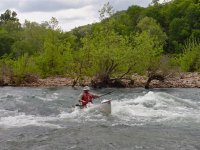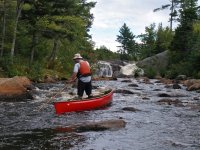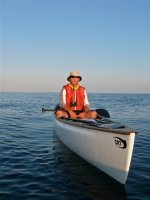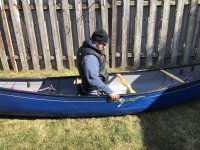The upper reaches of many wild river systems have huge lakes, and dangerous rapids lower on the river. What solo canoe would you take if your life depended on it?
-
Happy First Circulation of Canadian Coins (1858)! 🇨🇦 🪙
You are using an out of date browser. It may not display this or other websites correctly.
You should upgrade or use an alternative browser.
You should upgrade or use an alternative browser.
Bloodvein
- Thread starter Black_Fly
- Start date
The upper reaches of many wild river systems have huge lakes, and dangerous rapids lower on the river. What solo canoe would you take if your life depended on it?
I built and designed my own canoe for that trip (I did downstream and then back upstream, 30 days). I wanted capacity and speed (for upstream) while still retaining some maneuverability. It was 16.5' long and 30" wide with tons of flare up front to make room for a pack and the dog. Some rocker but not a lot. The next year I built another and changed the profile of the stems to make it more maneuverable but the original got me through the trip just fine. For most people it wouldn't have been the ideal canoe by a long shot but it fit perfectly with my paddling style and handled CII rapids, which is what I wanted.
Don't sweat the boat selection. You could do that trip in anything you wanted. There are a couple relatively large lakes but nothing all that special in terms of size or difficulty. The rapids all have well used portages around them so if you won't want to run whitewater then you don't have to. The rapids are short and so are most of the portages.
It's a beautiful river and a trip I'd certainly recommend. Challenging but not overwhelming. Mostly flatwater paddling as it's a pool and drop type of river so no appreciable current except at the rapids.
 P8220124 by Alan, on Flickr
P8220124 by Alan, on FlickrAlan
I have only semi-destroyed one cedar strip, like all at once, and even then it was repairable enough to get back to civilization, well, a road in the middle of no-where, but civilization is a relative concept.
In wilderness tripping settings, the standard application of whitewater grading is to raise the level of the rapid by one full rating. If one adheres to this tenant, most canoes will transport you anywhere. If, on the other hand, you paddle canoes like playing basketball, and use rocks for the rebound effect, go for royalex every time.
If you are a beast on portages, get a poly canoe, it's really hard to destroy those suckers, and they slide off rocks like crazy carpets on a snowhill. I did my best for over ten years to destroy a poly canoe, even carried the beast up Diablo portage, a process where the canoe won the destroying battle as I sucked wind like a rusty hoover. But in the end, it took a snow plow to finish the poly off. I was sad, that poly canoe had saved my life more than once, as I had disregarded the "raise the rapid classification rule" many times with it. In particular, the infamous trip with my son when I found out why the Drowning River was aptly named.
On the other hand, a solo poly probably wouldn't weigh more than 60 pounds if such a thing actually exists. Not sure if Mohawk made poly canoes as well as royalex, but I do recall their royalex solos were fairly heavy.
If I was doing the Bloodvein, I would probably use my latest cedar strip build, the Osprey. From what I have seen, the Bloodvein looks very similar to most of the river trips I have done in Northern Ontario, where the Osprey proved to be completely adequate.
In wilderness tripping settings, the standard application of whitewater grading is to raise the level of the rapid by one full rating. If one adheres to this tenant, most canoes will transport you anywhere. If, on the other hand, you paddle canoes like playing basketball, and use rocks for the rebound effect, go for royalex every time.
If you are a beast on portages, get a poly canoe, it's really hard to destroy those suckers, and they slide off rocks like crazy carpets on a snowhill. I did my best for over ten years to destroy a poly canoe, even carried the beast up Diablo portage, a process where the canoe won the destroying battle as I sucked wind like a rusty hoover. But in the end, it took a snow plow to finish the poly off. I was sad, that poly canoe had saved my life more than once, as I had disregarded the "raise the rapid classification rule" many times with it. In particular, the infamous trip with my son when I found out why the Drowning River was aptly named.
On the other hand, a solo poly probably wouldn't weigh more than 60 pounds if such a thing actually exists. Not sure if Mohawk made poly canoes as well as royalex, but I do recall their royalex solos were fairly heavy.
If I was doing the Bloodvein, I would probably use my latest cedar strip build, the Osprey. From what I have seen, the Bloodvein looks very similar to most of the river trips I have done in Northern Ontario, where the Osprey proved to be completely adequate.
- Joined
- Aug 21, 2018
- Messages
- 1,805
- Reaction score
- 2,219
. What solo canoe would you take if your life depended on it?
Under those conditions, I think the best solo canoe to have would be one containing a paddler with excellent skills, extensive experience and unfailingly good judgement. I have seen a few paddlers that can make a crappy boat perform better than many of us can do with the alleged perfect craft.
Well, since the portages are short, a little more weight might not be an issue. You definitely don't want any hull damage while alone, far from help. If rapids and portages come up quickly or unexpectedly (or showing incorrectly on a map), one would want a more responsive craft than a typical high capacity lake boat. Seasonal water flow could also be a factor affecting craft choice. I have been paddling in the backcountry for over half a century. I'm not the most skilled, but I ALWAYS try to be prepared. Likely the pandemic won't allow a trip this year, but I've been studying maps and Haps book for ten years. Maybe next year.
- Joined
- Aug 21, 2018
- Messages
- 1,805
- Reaction score
- 2,219
In wilderness tripping settings, the standard application of whitewater grading is to raise the level of the rapid by one full rating. If one adheres to this tenant, most canoes will transport you anywhere. If, on the other hand, you paddle canoes like playing basketball, and use rocks for the rebound effect, go for royalex every time.
I have also seen this quote many times, mem. My interpretation, perhaps incorrect, is that the implications of a mistake are more serious in true wilderness setting. But in reality, the rapid is still the same rapid. For example, Kathleen and I ran all 43 rapids in the 50 Km (30 miles) known as the “Rock Gardens” in the upper South Nahanni River. Two of these were rated in guide books as Class IV. There’s no way we could run a Class V. Didn’t have to, though, because it was still a Class IV.
There’s been only one time when I raised the level of difficulty of a rapid in a wilderness setting, and that was on the Thelon River. It had been very windy that day, and the canoe was often suddenly blown sideways in strong gusts. Kathleen and I had stopped to scout a fairly long Class II rapid. “What do you think, Michael? We can run this.”
”But it’s windy, Kathleen.”
”You mean you don’t want to run because it’s windy.” There was some incredulity in her voice.
”Some of those downstream Vs are pretty narrow. We could get blown off course at the last moment, and miss the V.”
”Michael, we gotta run what we know we can run.”
So we ran. Despite the wilderness setting, it was still a fairly straightforward Class II. It was not a Class III.
OK, members. Pile on me if you will. But I’m not changing my mind. After all, Kathleen and I have been paddling wilderness rivers since about 1988, usually by ourselves, We’ve never capsized yet, and have run the vast majority of rapids along the way.
If rapids and portages come up quickly or unexpectedly (or showing incorrectly on a map), one would want a more responsive craft than a typical high capacity lake boat.
In my experience (at high flows) nothing snuck up on you. Current is negligible so you're not being pushed downstream into anything and as I remember rapid locations were all correctly marked on my map and it was obvious when you were approaching one. Current generally remained low right up to the edge of the rapid and I was often able to sneak right up to a rock ledge at the very head of the rapids to cut down on portage length. My map didn't show any of the portage locations and I didn't transfer any over from Hap's book. There were only one or two that I struggled to find heading downstream. The river is traveled enough that the portage landings are usually obvious and are in logical locations for the most part.
I believe you own a Bell Magic and I used to own one as well so I'll use it as an example. It wouldn't be my first choice of boats for that trip but if that's what I had I wouldn't think twice about making the trip with it. All else being equal a Magic would just mean portaging more rapids.
The Bloodvein was my introduction to whitewater paddling and it was a good river for it. C1-C3 rapids were generally short and safe from the standpoint that there were few obstructions and most rapids contained a couple nice big eddies at the bottom. So in the case of a capsize the worst that was likely to happen is that you got wet and collected your gear below the rapids in the eddy. Since current was negligible having something wash away wasn't much of a concern.
I learned a ton about reading water, running rapids, and myself on that trip, all positive. I only capsized once and that was heading upstream when two close together but opposing (and very swift) eddy lines whipped me back and forth at the foot of a large rapid. I took more chances early in the day on nice days and fewer chances late in the day or in cold weather.
Like Pitt said above the paddler and their ability to adapt and make the correct decisions is the most important thing.
Alan
Of course you are right, Mr. Pitt. As a younger fella, I generally disregarded the advise, even on solo trips.My interpretation, perhaps incorrect, is that the implications of a mistake are more serious in true wilderness setting.
A big thing in the world of teaching right now is to "use your professional Judgement". In other words, with all this Covid stuff, on-line classes, blended learning, infrequent attendance, etc, we are supposed to rely on our professional judgement to help us through these new and difficult times. I guess wilderness tripping is much the same, after accumulating years of experience, one can usually make a correct judgement. However, in lieu of experience, the sage advise is often a good thing to heed.
Alan has described the nature of thousands of rivers all over Northern Ontario, pool and drop. It is difficult to get into ultimate trouble on these rivers if you are well prepared and have basic white water experience. If you do capsize, the yard sale of equipment should be waiting for you in one of the eddies at the the bottom of the rapid.
When I was a youngster of about 40, I decided I would run every rapid on the Kapikotongwa river. I was in a solo canoe. I got seriously trashed in the last chute, all because I didn't want to do a 200 meter portage. Portages almost always exist for a reason, sometimes they can be avoided, but I have come to respect the feeling in my gut that leaves a question mark in my brain. If I'm not sure I can make it, I no longer run it.
I guess the long and short of it is that experience and judgement are probably more important than the construction of the canoe. After all, for a few thousand years, most of the rivers were travelled by birchbark canoes.
I guess the long and short of it is that experience and judgement are probably more important than the construction of the canoe. After all, for a few thousand years, most of the rivers were travelled by birchbark canoes.
I generally agree with that.
However, if the trip was mainly flatwater with lots of long portages between lake basins and no rapids, I would opt for a very lightweight composite canoe.
On the other hand, if it was a long river trip with lots of rocks and rapids, even easy ones well within my whitewater skill level, I'd opt for a deep Royalex canoe for its flexibility, bash-ability, spring-from-pin-ability, and drag-over-rocks-ability.
If it was something in between, I'd feel most comfortable in my deep S-glass/Kevlar Hemlock SRT as the best combi lake/whitewater canoe I know. It was designed by canoe legend Harold Deal specifically for solo wilderness tripping in Canada on river systems with big connecting lakes. Here's Harold in an SRT on the Buffalo River, Oswegatchie River and crossing Lake Ontario.



That SRT sure is a fine looking canoe, unfortunately it is a very rare bird in Canada.
Similar threads
- Replies
- 13
- Views
- 2K
- Replies
- 15
- Views
- 2K

